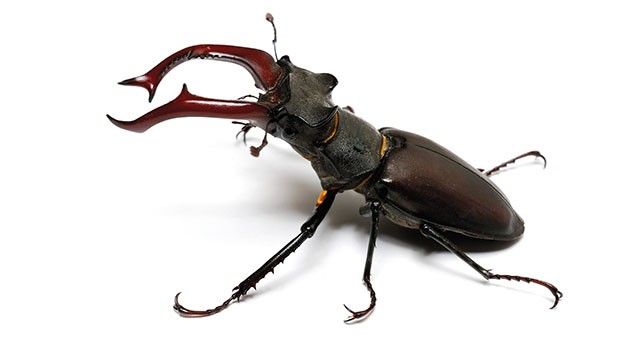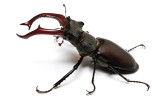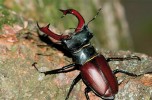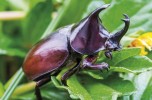Il più grosso coleottero d’Europa che abita negli alberi… in estinzione
Il cervo volante (nome scientifico Lucanus cervus) è il più grosso coleottero d’Europa. Diffuso anche in Asia Minore e Medio Oriente, in Italia si trova soprattutto nelle regioni settentrionali e vive solitamente nelle cavità dei tronchi d’albero e nei ceppi.
L’insetto deve il suo nome alla presenza di due strutture nella parte anteriore del corpo che ricordano proprio le corna di un cervo; esse, in realtà, non sono altro che mandibole molto sviluppate, più nel maschio che nella femmina. Le corna vengono utilizzate soprattutto durante i combattimenti nel periodo riproduttivo e fanno apparire il maschio molto più terribile di quanto non sia in realtà; i muscoli a cui sono collegate, infatti, sono troppo deboli per riuscire a muoverle, pertanto risultano del tutto inoffensive. Le femmine, invece, avendole più piccole, sono in grado di pizzicare con forza e provocare maggiore danno.
Mandibole che fan la differenza…
I duelli che i maschi sostengono per accaparrarsi le femmine sono zuffe furibonde in cui l’uno cerca di mettere in fuga l’altro, o addirittura di farlo cadere dall’albero, che considera suo territorio. Nel cervo volante sono proprio le mandibole a distinguere il sesso. Tra gli stessi maschi variano molto sia la forma che la dimensione, tant’è che si è arrivati a ipotizzare l'esistenza di due morfologie distinte.
Gli esemplari più grandi investono molta energia nello sviluppo delle corna e questo può avere degli effetti negativi sulla loro probabilità di sopravvivenza; è anche vero, però, che la dimensione delle corna li avvantaggia nei combattimenti e nell’accoppiamento. Il coleottero si muove spesso anche in volo; possiede due paia di ali, le prime molto robuste e prive di nervatura, le seconde più leggere ripiegate sotto le prime.
Le fasi di crescita e sviluppo
Lo sviluppo di un cervo volante può durare dai tre ai sei anni, anche dieci per arrivare a esemplari maschi ben formati. Le uova vengono deposte alla base di ceppi di alberi vecchi o morenti, in insenature incise dalle mandibole della femmina; per la deposizione delle uova tendono a preferire alberi di quercia, castagno, faggio, salice e pioppo. Alla schiusa vengono alla luce delle larvette chiare con mandibole già potenti, utilizzate per incidere il legno e scavare lunghe gallerie. Quando hanno raggiunto i dieci centimetri di lunghezza preparano una celletta nel legno in cui si rintanano per compiere la propria metamorfosi.
Dopo cinque o sei anni le larve diventano finalmente pupe ed escono all’aperto, non prima del giugno successivo. La loro aspettativa di vita è di circa due mesi per i maschi, quattro per le femmine. Nel mondo esistono più di mille specie diverse di cervo volante, di dimensioni e forme differenti, dai colori più brillanti a quelli bruni e scuri. Eppure, come accade con gli altri coleotteri del legno, l’insetto è in declino per via della riduzione o la distruzione totale del suo habitat naturale, in particolare per via delle pratiche forestali che tendono a eliminare i vecchi tronchi.
Laura Spataro

Traduzione in inglese a opera di ViceVersa Group
Stag beetle: don’t call them antlers, they’re attack jaws. The largest beetle in Europe which lives in trees... near extinction
The stag beetle (Lucanus cervus is its scientific name) is the largest beetle in Europe. Widespread in Asia Minor and the Middle East too, in Italy it is found principally in the northern regions and generally lives in cavities in tree trunks and branches. It owes its name to the presence of two structures in the upper part of its body which resemble the antlers of a deer.
These are actually highly developed jaws which are larger in males than in females. These antlers are used principally during combat in the mating season and make males look much more impressive than they really are. The muscles they are linked to are actually too weak to be moved and they are thus entirely inoffensive. The females with their smaller ‘antlers’, are, on the other hand, capable of a pincer movement and can thus do greater damage.
Jaws which make the difference...
The duels that the males engage in to capture the attention of females are furious fights in which one attempts to drive away another or even threatens to knock it off a tree which it considers its territory. In Lucanus cervus it is precisely the jaws which mark out gender. They vary greatly in both shape and size between males and it has thus been hypothesised that two distinct morphologies exist. The largest beetles invest a great deal of energy in developing their antlers and this can have negative effects on their chances of survival. It is, however, also true that antler size is a combat and mating advantage. These beetles frequently move around by flying and have two pairs of wings, the first very strong and without nerves while the second are lighter and folded under the former.
Growth and development phases
The development of a beetle can last from three to six years and even as much as ten for a well-formed male. The eggs are laid at the base of an old or dying tree trunk in grooves carved out by females’ jaws. Oak, chestnut, beech, willow and poplar tend to be the preferred trees. When they open, pale coloured larvae emerge with already powerful jaws used to carve wood and dig out long tunnels. When they reach ten centimetres in length they prepare a small cell in the wood in which they make their burrows to complete their metamorphosis. Five or six years later the larvae are finally pupa and come out into the open no earlier than the following June. Their life expectancy is around two months for males and four for females. There are more than one thousand species of stag beetle in various sizes and shapes and colours ranging from the brightest to dark brown coloured. Numbers of this insect are falling, in common with other wood beetles, as a result of the reduction in size or total destruction of its natural habitat, in particular as a result of forest practices which tend to eliminate old tree trunks.

















